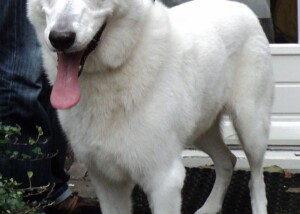
What is the earliest brain tumor sign in a dog?
I can only speak from my experience with my parents’ German shepherd.
But I’m sure that this very early sign of a brain tumor in a dog is not unique.
If you’ve been noticing subtle changes in your dog’s behavior lately, do not be satisfied passing this off to “old age” or “he’s getting older” or anything like that.
When I think about it, the earliest sign that something wasn’t quite right with the dog was that he wasn’t as enthusiastic about maintaining play with a ball. Note the key word here: maintaining.
The dog was responding as enthusiastically as always to the “Let’s Play!” signals, which were verbal or visual.
And at the beginning of the play sessions, he was exuberant and puppy-like, though over eight and a half years old. But soon after he’d lose interest.
Normally, the dog went for 35 throws in the backyard, retrieving the ball to me, and then at around throw No. 35 (though historically sometimes about 30), instead of bringing the ball to me, he’d pause at the stairs leading up to the deck; this was his communication, since youth, that he wanted to go inside and drink a lot of water.

The dog was now doing this only after about 10 throws.
But I didn’t think anything of it, and figured maybe it was the arthritis in his knee that he’d been diagnosed with some weeks prior.
Maybe he was getting older, even though only weeks before, he was bounding around like a puppy in the snow, and recently had gone for 40 throws.
Indoors we had a game: I’d stand by a particular door and kick a football-shaped chew toy across the kitchen walkway which was lengthy enough for the dog to bolt after the toy, then bring it back to me. He’d do this until his master had had enough.
I was noticing that he’d retrieve only a few times, then go to his pillow and plop down.
Or, he’d proceed to retrieve, but not follow through and instead veer off to his pillow. Again, I didn’t think much of it.
These were the earliest signs of a brain tumor that he’d be diagnosed with just a several weeks later a few days after his first seizure.
The brain tumor was insidiously changing the dog’s personality; I don’t want to say attitude or intelligence; this seemed mostly like a personality thing. By no means was the dog lethargic; he had plenty of energy.
He just didn’t want to maintain play. I realized that dogs eventually get old and tired, but this dog’s ninth birthday was several months off yet, and when the aging process slows canines down, it doesn’t happen this rapidly: from 40 throws in late January to just 10 or seven throws in mid February?
Another effect of the brain tumor was that the dog began coming back to me without the ball.
I’d have to keep telling him to go get it, walking towards it, pointing to it, sometimes getting it for him, as though he was either forgetful or simply lost interest, I couldn’t tell which. I thought he was just being stubborn.
Historically, fetching sessions included the dog retrieving the ball and then continuing on around a corner in the yard, ball in mouth, to relieve himself, then returning to me with the ball.
But now, he was not only relieving himself and returning to me without the ball, but he kept making that leftward excursion to the area where he’d normally relieve himself.
He kept wanting to go over there, but at the time, it didn’t occur to me that the “leftwardness” was the lure, not the actual relieving area.
(Several days preceding the brain tumor diagnosis, the dog kept circling around the kitchen leftward; and since then, had a persistent compulsion to circle leftward and make left turns in the house; the brain tumor was on the right side of the brain.)
The relieving area was hidden by the façade of the house, so I never knew what he was doing back there.
I’d approach and there the dog would be, just standing there, looking towards me, not in the act of any defecation, ball not in mouth.
I’d tell him to get the ball; he wouldn’t. He’d continue standing there or come to me, no ball.
Sometimes he’d trot up to the deck after I told him to get the ball; the ball was not on the deck.
It was in the yard either not touched after being thrown by me, or having been carried over to the defecation area by the dog, but then apparently forgotten that it had been deposited there.
The dog would be trotting around on the deck as though searching for the ball, looking down at me. Despite all this, it never dawned on me that a brain tumor was at work.
Though these were the earliest signs of the brain tumor, this didn’t mean that the brain tumor was small.
Often, by the time a brain tumor in a dog begins presenting with symptoms, the brain tumor is large.
Other than these lapses during playtime, which I called “disorientation” and “he seems to forget why we’re out there,” the dog was completely normal — for a few weeks, that is.
But then other symptoms began showing up, such as not showing interest in other dogs nearby, when normally he’d bark like crazy.
Really, who starts thinking brain tumor when subtle behavior changes in a dog start occurring? Some well-informed people actually do start suspecting a brain tumor.
But a brain tumor in our dog was the furthest thing from our mind.
Other symptoms started showing up over just a matter of days, and then he had the seizure, which led to a complete workup of his body, but not his brain (the vet clinic wasn’t equipped for a neurological exam).
When the vet called and said everything in the dog’s body was in magnificent shape (heart, lungs, liver, kidneys, blood work, chest X ray), my mother was thrilled.
Not me. I told her, “If everything in his body is healthy, that means the problem is in his brain!”
With his body being in perfect condition, this meant that the seizure could have only been caused by a brain tumor, or quite possibly another condition that the vet called “doggie dementia.”
Or possibly cerebral inflammation. Well, by then, I just knew the dog had a brain tumor.
The diagnosis a few days later was a “fairly large tumor” in the “thinking part of the brain.”
Within several days of the diagnosis, the dog had pretty much lost all interest in play sessions, and never recovered his enthusiasm for retrieving balls.
If your dog starts exhibiting behaviors that are peculiar, out of character, or cannot truly be explained by age, fatigue, a change in diet, or stress — it certainly wouldn’t hurt to get an MRI of the dog’s brain; an MRI is the only way to diagnose a brain tumor in a dog, and the earlier, the better.
 Lorra Garrick has been covering medical, fitness and cybersecurity topics for many years, having written thousands of articles for print magazines and websites, including as a ghostwriter. She’s also a former ACE-certified personal trainer.
Lorra Garrick has been covering medical, fitness and cybersecurity topics for many years, having written thousands of articles for print magazines and websites, including as a ghostwriter. She’s also a former ACE-certified personal trainer.
.









































